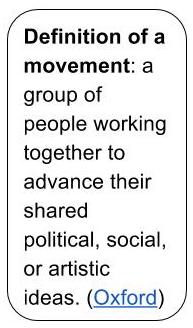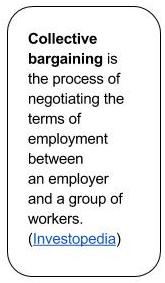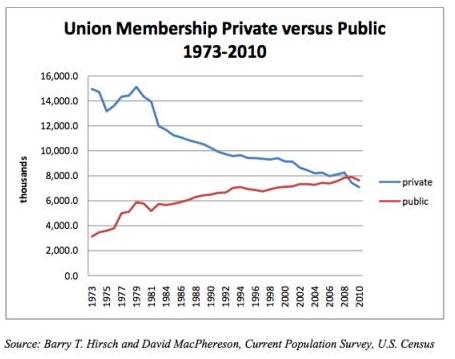This year, as we come together as a nation to celebrate Labor Day, let’s pause to understand where a movement which began in 1881 to protect workers is at in its mission.

 When were the first unions formed? The Federation of Organized Trades and Labor Unions was formed in 1881, and the American Federation of Labor (AFL) was founded five years later.
When were the first unions formed? The Federation of Organized Trades and Labor Unions was formed in 1881, and the American Federation of Labor (AFL) was founded five years later.
What was their purpose? For private sector workers, particularly “those in the industrial sector, organized labor unions fought for better wages, reasonable hours and safer working conditions. The labor movement led efforts to stop child labor, give health benefits and provide aid to workers who were injured or retired.” (History Channel) These terms of employment were, and still are, often settled in a collective bargaining agreement between the union and the employer. The attempt to reach this agreement is what has led to the gamesmanship and strikes that garner media attention.
Here is a more recent list of services provided by unions today, from a pro union source. One that stood out to me is access to information. Given the focus on workers’ rights, union workers may be more aware – and better prepared to make use – of benefits available to all workers.
So then, what is a public sector union? These are unions that represent government employees at the local, state and federal level – such as, teachers, firefighters, police officers, healthcare workers, postal workers and any other employee of the government. (Open Secrets) One of the first public sector unions formed in 1889, the National Association of Letter Carriers.
President Franklin D. Roosevelt is often referred to as an ardent supporter of collective bargaining, but not collective bargaining for public sector employees.
 Paraphrasing from his 1937 letter to the president of the National Federation of Federal Employees, President Roosevelt addressed the “special relationships and obligations of public servants to the public itself and to the Government.” He went on to explain that, “Upon employees in the Federal service rests the obligation to serve the whole people, whose interests and welfare require orderliness and continuity in the conduct of government activities…looking toward the paralysis of Government by those who have sworn to support it, is unthinkable and intolerable.”
Paraphrasing from his 1937 letter to the president of the National Federation of Federal Employees, President Roosevelt addressed the “special relationships and obligations of public servants to the public itself and to the Government.” He went on to explain that, “Upon employees in the Federal service rests the obligation to serve the whole people, whose interests and welfare require orderliness and continuity in the conduct of government activities…looking toward the paralysis of Government by those who have sworn to support it, is unthinkable and intolerable.”
In 1962, President Kennedy changed course and extended collective bargaining rights to federal workers.
What does union membership look like now? Union membership and power peaked in the 1970’s, after which private sector union membership began its steady decline. Meanwhile, membership in public sector unions has experienced a steady increase since that time.

The right-to-work debate: Who has to pay union dues?
In right-to-work states, “Labor unions still operate… but workers cannot be compelled to become members as a requirement of their job.” And, in these states, non-union members are not required to pay union dues. (National Conference of State Legislators – NCSL)
At the heart of the debate is this question, should unions collect fair share “fees from those who don’t join the union but benefit from a contract that covers them”? (NPR) Over the years, the debate around these “fair share” mandatory union dues has found its way to the Supreme Court. A case to watch is Janus v. AFSCME which seeks to overturn Abood v. Detroit Board of Education. Abood is a 1977 case that upheld the practice of mandatory union dues.
If Abood is overturned, all states would be right-to-work for public sector employees.
While the Supreme Court deliberates, states have responded to workers who don’t want to join a union or pay dues. As of August 2017, 28 states and Guam had adopted right-to-work laws. (NCSL) Becoming a right-to-work state does not preclude strong collective bargaining laws, as can be seen in the cases of Nebraska, Florida and North Dakota. (Mercatus)
As private sector union membership declines, dwindling dues is a concern for union leadership. With the changed landscape since the late 1800’s and early 1900’s, labor unions may be struggling to find their footing, but no one benefits if the labor movement begins creating problems to solve.
This WSJ editorial highlights this troubling trend. To recap, Missouri workers voted for a right-to-work governor, who pledged to to turn their state into a right-to-work state. That promise was delivered in February of this year. In response, union leadership is organizing a campaign to fight against the determination. And in doing so, the editorial concludes – “Big Labor will be spending the same compulsory dues money that it’s fighting to keep.” More importantly, labor leaders are spending member dues to solve a problem that the majority of workers in that state don’t believe exists.
So what can you do?
- Is your state a right to work state?
- Who are the unions in your state?
- What is their budget and how much do they spend on political campaigns?
- Stay up to date on the Janus v. AFSCME case.
It’s a movement!
Recommend a Circle Leader. Especially in Nebraska, Wisconsin, Minnesota and Missouri where circles are sprouting.
Start a Circle in your neighborhood. Add value in your community by giving women the facts and the space to strengthen their understanding of the issues.
Invest in The Policy Circle. Together let’s build a network of women who want to assume their civic duties and understand the impact of policy in their lives.
The Policy Circle is a 501(c)3 that provides a fact-based, nonpartisan framework that inspires women living in the same community to connect, learn about and discuss public policies that impact their lives. Women across the nation are taking a leadership role in public policy dialogue on what human creativity can accomplish in a free market economy.